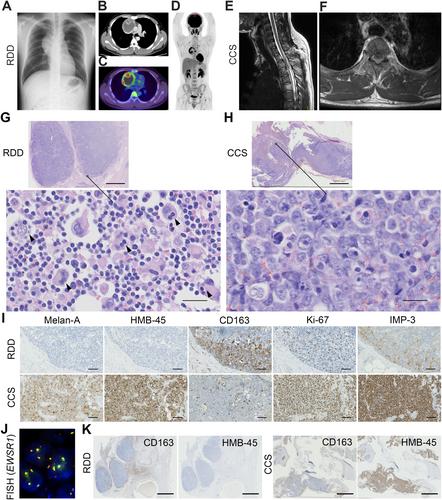Common progenitor origin for Rosai–Dorfman disease and clear cell sarcoma
Aki Sato, Nozomi Yusa, Hiroyuki Takamori, Eigo Shimizu, Kazuaki Yokoyama, Satoshi Ichikawa, Hisayuki Yokoyama, Yuki Kasahara, Kodai Enda, Fumiyoshi Fujishima, Ryo Ichinohasama, Yasunori Ota, Seiya Imoto, Yasuhito Nannya
下载PDF
{"title":"Common progenitor origin for Rosai–Dorfman disease and clear cell sarcoma","authors":"Aki Sato, Nozomi Yusa, Hiroyuki Takamori, Eigo Shimizu, Kazuaki Yokoyama, Satoshi Ichikawa, Hisayuki Yokoyama, Yuki Kasahara, Kodai Enda, Fumiyoshi Fujishima, Ryo Ichinohasama, Yasunori Ota, Seiya Imoto, Yasuhito Nannya","doi":"10.1002/path.6345","DOIUrl":null,"url":null,"abstract":"<p>Histiocytic neoplasms (HNs) in adults have been reported to be associated with a high prevalence of coexisting haematological and solid malignancies. While a proportion of coexisting HNs and haematological malignancies share identical genetic alterations, the genetic association between HNs and solid malignancies has scarcely been reported. We report a case of Rosai–Dorfman disease (RDD) complicated by coexisting clear cell sarcoma (CCS). RDD is a rare HN. CCS is an ultrarare soft tissue sarcoma with a poor prognosis. Mutation analysis with whole-exome sequencing revealed six shared somatic alterations including <i>NRAS</i> p.G12S and <i>TP53</i> c.559+1G>A in both the RDD and CCS tissue. This is the first evidence of a clonal relationship between RDD and solid malignancies using mutational analysis. We hypothesise that neural crest cells, which originate in CCS, are likely the common cells of origin for RDD and CCS. This case helps to unravel the underlying clinicopathological mechanisms of increased association of solid malignancies in HNs. © 2024 The Author(s). <i>The Journal of Pathology</i> published by John Wiley & Sons Ltd on behalf of The Pathological Society of Great Britain and Ireland.</p>","PeriodicalId":232,"journal":{"name":"The Journal of Pathology","volume":"264 3","pages":"243-249"},"PeriodicalIF":5.6000,"publicationDate":"2024-09-03","publicationTypes":"Journal Article","fieldsOfStudy":null,"isOpenAccess":false,"openAccessPdf":"https://onlinelibrary.wiley.com/doi/epdf/10.1002/path.6345","citationCount":"0","resultStr":null,"platform":"Semanticscholar","paperid":null,"PeriodicalName":"The Journal of Pathology","FirstCategoryId":"3","ListUrlMain":"https://onlinelibrary.wiley.com/doi/10.1002/path.6345","RegionNum":2,"RegionCategory":"医学","ArticlePicture":[],"TitleCN":null,"AbstractTextCN":null,"PMCID":null,"EPubDate":"","PubModel":"","JCR":"Q1","JCRName":"ONCOLOGY","Score":null,"Total":0}
引用次数: 0
引用
批量引用
Abstract
Histiocytic neoplasms (HNs) in adults have been reported to be associated with a high prevalence of coexisting haematological and solid malignancies. While a proportion of coexisting HNs and haematological malignancies share identical genetic alterations, the genetic association between HNs and solid malignancies has scarcely been reported. We report a case of Rosai–Dorfman disease (RDD) complicated by coexisting clear cell sarcoma (CCS). RDD is a rare HN. CCS is an ultrarare soft tissue sarcoma with a poor prognosis. Mutation analysis with whole-exome sequencing revealed six shared somatic alterations including NRAS p.G12S and TP53 c.559+1G>A in both the RDD and CCS tissue. This is the first evidence of a clonal relationship between RDD and solid malignancies using mutational analysis. We hypothesise that neural crest cells, which originate in CCS, are likely the common cells of origin for RDD and CCS. This case helps to unravel the underlying clinicopathological mechanisms of increased association of solid malignancies in HNs. © 2024 The Author(s). The Journal of Pathology published by John Wiley & Sons Ltd on behalf of The Pathological Society of Great Britain and Ireland.
罗赛-多夫曼病和透明细胞肉瘤的共同祖细胞起源。
据报道,成人组织细胞瘤(HNs)与并存的血液和实体恶性肿瘤发病率很高。虽然一部分同时存在的组织细胞瘤和血液恶性肿瘤具有相同的基因改变,但组织细胞瘤和实体恶性肿瘤之间的基因关联却鲜有报道。我们报告了一例罗赛-多夫曼病(RDD)并发透明细胞肉瘤(CCS)的病例。RDD 是一种罕见的 HN。透明细胞肉瘤(CCS)是一种超稀有软组织肉瘤,预后较差。全外显子组测序的突变分析显示,RDD和CCS组织中存在6个共同的体细胞改变,包括NRAS p.G12S和TP53 c.559+1G>A。这是首次利用突变分析证明 RDD 与实体恶性肿瘤之间存在克隆关系的证据。我们推测,起源于 CCS 的神经嵴细胞可能是 RDD 和 CCS 的共同起源细胞。本病例有助于揭示HNs与实体恶性肿瘤关联性增加的潜在临床病理机制。© 2024 作者。病理学杂志》由 John Wiley & Sons Ltd 代表大不列颠及爱尔兰病理学会出版。
本文章由计算机程序翻译,如有差异,请以英文原文为准。




